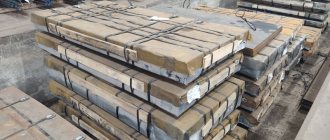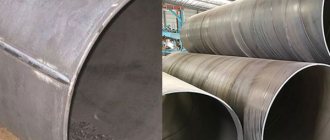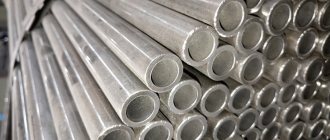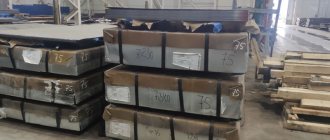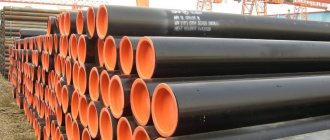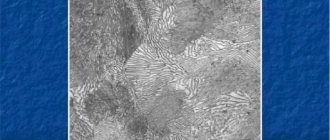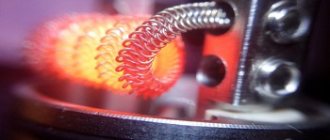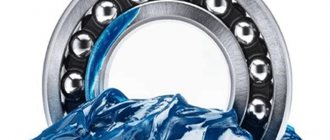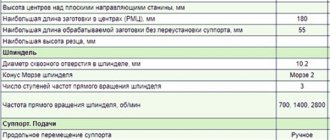Steel 45
Total information
| Substitute |
| Steel 40Х, Steel 50, Steel 50G2 |
| Type of delivery |
| Long products, including shaped steel: GOST 1050-74, GOST 2590-71, GOST 2591-71, GOST 2879-69, GOST 8509-86, GOST 8510-86, GOST 8239-72, GOST 8240-72, GOST 10702 -78. |
Calibrated rod GOST 1050-74, GOST 7414-75, GOST 8559-75, GOST 8560-78, GOST 10702-78.
Thick sheet GOST 1577-81, GOST 19903-74.
Thin sheet GOST 16523-70. Tape GOST 2284-79.
Strip GOST 1577-81, GOST 103-76, GOST 82-70.
Wire GOST 17305-71, GOST 5663-79.
Forgings and forged blanks GOST 8479-70, GOST 1131-71.
Chemical composition (according to GOST 1050-2013)
| Chemical element | % |
| Carbon (C) | 0.42-0.50 |
| Silicon (Si) | 0.17-0.37 |
| Copper (Cu), no more | 0.25 |
| Arsenic (As), no more | 0.08 |
| Manganese (Mn) | 0.50-0.80 |
| Nickel (Ni), no more | 0.25 |
| Phosphorus (P), no more | 0.035 |
| Chromium (Cr), no more | 0.25 |
| Sulfur (S), no more | 0.04 |
Mechanical properties
Mechanical properties at elevated temperatures
| test t, °C | σ0.2, MPa | σB, MPa | δ5, % | δ, % | ψ, % | KCU, J/m 2 |
| Normalization | ||||||
| 200 | 340 | 690 | 10 | 36 | 64 | |
| 300 | 255 | 710 | 22 | 44 | 66 | |
| 400 | 225 | 560 | 21 | 65 | 55 | |
| 500 | 175 | 370 | 23 | 67 | 39 | |
| 600 | 78 | 215 | 33 | 90 | 59 | |
| Specimen with a diameter of 6 mm and a length of 30 mm, forged and normalized. Deformation speed 16 mm/min. Strain rate 0.009 1/s. | ||||||
| 700 | 140 | 170 | 43 | 96 | ||
| 800 | 64 | 110 | 58 | 98 | ||
| 900 | 54 | 76 | 62 | 100 | ||
| 1000 | 34 | 50 | 72 | 100 | ||
| 1100 | 22 | 34 | 81 | 100 | ||
| 1200 | 15 | 27 | 90 | 100 | ||
Mechanical properties of rolled products
| Heat treatment, delivery condition | Section, mm | σB, MPa | δ5, % | δ4, % | ψ, % | |
| Hot-rolled, forged, calibrated and silver steel of the 2nd category after normalization | 25 | 600 | 16 | 40 | ||
| Calibrated steel of the 5th category after hardening | 640 | 6 | 30 | |||
| Steel, calibrated and calibrated with a special finish after tempering or annealing | 2 | HB | ||||
| Quenching 850 °C, water. Samples with a diameter of 15 mm | ||||||
| 450 | 830 | 980 | 10 | 40 | 59 | |
| 500 | 730 | 830 | 12 | 45 | 78 | |
| 550 | 640 | 780 | 16 | 50 | 98 | |
| 600 | 590 | 730 | 25 | 55 | 118 | |
| Quenching 840 °C, water. Workpiece diameter 60 mm | ||||||
| 400 | 520-590 | 730-840 | 12-14 | 46-50 | 50-70 | 202-234 |
| 500 | 470-520 | 680-770 | 14-16 | 52-58 | 60-90 | 185-210 |
| 600 | 410-440 | 610-680 | 18-20 | 61-64 | 90-120 | 168-190 |
Mechanical properties depending on the section
| Section, mm | σ0.2, MPa | σB, MPa | δ5, % | ψ, % | KCU, J/m 2 |
| Quenching 850 °C, tempering 550 °C. Samples were cut from the center of the blanks. | |||||
| 15 | 640 | 780 | 16 | 50 | 98 |
| 30 | 540 | 730 | 15 | 45 | 78 |
| 75 | 440 | 690 | 14 | 40 | 59 |
| 100 | 440 | 690 | 13 | 40 | 49 |
Technological properties
| Forging temperature |
| Start 1250, end 700. Sections up to 400 mm are cooled in air. |
| Weldability |
| Difficult to weld. Welding methods: RDS and KTS. Heating and subsequent heat treatment are required. |
| Machinability |
| In the hot-rolled state at HB 170-179 and sB = 640 MPa Ku tv.all. = 1, Ku b.st. = 1. |
| Tendency to release ability |
| Not inclined. |
| Flock sensitivity |
| Insensitive. |
Critical point temperature
| Critical point | °C |
| Ac1 | 730 |
| Ac3 | 755 |
| Ar3 | 690 |
| Ar1 | 780 |
| Mn | 350 |
Impact strength
Impact strength, KCU, J/cm 2
| Delivery condition, heat treatment | +20 | -20 | -40 | -60 |
| Rod with a diameter of 25 mm. Hot rolled condition. | 14-15 | 10-14 | 5-14 | 3-8 |
| Rod with a diameter of 25 mm. Annealing | 42-47 | 27-34 | 27-31 | 13 |
| Rod with a diameter of 25 mm. Normalization | 49-52 | 37-42 | 33-37 | 29 |
| Rod with a diameter of 25 mm. Hardening. Vacation | 110-123 | 72-88 | 36-95 | 31-63 |
| Rod with a diameter of 120 mm. Hot rolled condition | 42-47 | 24-26 | 15-33 | 12 |
| Rod with a diameter of 120 mm. Annealing | 47-52 | 32 | 17-33 | 9 |
| Rod with a diameter of 120 mm. Normalization | 76-80 | 45-55 | 49-56 | 47 |
| Rod with a diameter of 120 mm. Hardening. Vacation | 112-164 | 81 | 80 | 70 |
Endurance limit
| σ-1, MPa | τ-1, MPa | σB, MPa | σ0.2, MPa |
| 245 | 157 | 590 | 310 |
| 421 | 880 | 680 | |
| 231 | 520 | 270 | |
| 331 | 660 | 480 |
Hardenability
Hardness for hardenability strips HRCе (HRB).
Use of special coolants
During the technological process, water is mainly used to cool parts. The quality of the coolant can be changed by adding soda or special salts, which can affect the cooling process of the workpiece.
To preserve the hardening process, it is strictly forbidden to use the water contained in it for extraneous operations. The water must be clean and have a temperature of 20 to 30 °C. It is forbidden to use running water to harden steel.
Composition of mixtures of salts and alkalis used as quenching media
This hardening method is used only for cemented products or those with a simple shape.
Products with complex shapes made from special structural steel are cooled in a 5% caustic soda solution at a temperature of 50-60 °C. The hardening operation is carried out in a room equipped with exhaust ventilation. Mineral oils are used to harden workpieces made of high-alloy steel, and the cooling rate in an oil bath does not depend on the oil temperature. Mixing oil and water is unacceptable, as this can lead to cracks in the metal.
When quenching in an oil bath, a number of rules must be followed:
- Be careful not to ignite the oil.
- When the metal cools in the oil, harmful gases are released (exhaust ventilation is required).
- Plaque forms on the metal.
- Oil loses its properties when intensively used to cool metal.
When carrying out the hardening process of steel 45, it is necessary to follow the technological process in compliance with all operations.
Alloy marking
Structural high-quality carbon steels are marked according to the standard with a two-digit number: steel 05, 08...80, 85, which indicates the average value of carbon content expressed in hundredths of a percent.
Three digits of the marking indicate that the alloy contains more than 1% carbon, the letter L indicates the absence of alloying - 45l, the letter St indicates its ordinary quality - St5. The metallurgical industry produces standard steel grades from 05kp to 60, the average carbon index of which is 0.05-0.60 percent, according to the marking. Decoding steel grade 45 (French analogue of C45) shows a content of 0.45% C.
Main characteristics of steel 45
Any alloy has its own distinctive characteristics, a certain chemical composition, a number of substitutes, and a functional purpose.
Grades 40, 45, 50 are distinguished by their high strength levels, while having low viscosity and ductility. Since the mechanical properties of grade and 45 are identical to grades 40 and 50, these steels are interchangeable.
Chemical composition and properties
The chemical components of the alloy, in addition to iron and carbon, are a number of other elements, the amount of which is insignificant. The percentage of chemical components of steel 45:
Application of protective measures
During the heat treatment process, carbon gradually burns out and scale forms. To prevent deterioration of the quality of the metal and protect it, shielding gases are used, which are pumped during the hardening process. Ammonia or methane gas is pumped into the furnace, which has a sealed chamber, where heat treatment occurs using a special generator.
In the absence of sealed furnaces, processing operations are carried out in a special sealed container, into which cast iron shavings are first poured to prevent carbon burnout.
When processing workpieces in salt baths, the metal is protected from oxidation, and to create the necessary conditions for maintaining the carbon level, the contents of the bath are deoxidized 2 times during the day with boric acid, blood salt or borax. At processing temperatures in the temperature range of 760-1000 °C, charcoal can be used as a deoxidizing agent.
Chemical composition
If you decipher the steel grade 45, you can understand that the numbers indicate the quantitative carbon content. Typically it ranges from 0.42 to 0.5%. The alloy also contains other components, the concentration of some of them is insignificant and does not have a special effect on the properties of the material:
- silicon – 0.17 – 0.37%;
- manganese – 0.5-0.8%;
- chromium, copper and nickel – up to 0.25%;
- arsenic – up to 0.08%.
According to its characteristics, steel 45 belongs to the class of high-quality carbon steels. The level of quality in the marking is indicated by the word “steel”. The indicator is determined by the content of harmful impurities: sulfur – 0.04%; phosphorus – 0.035%.
Being integrated into the crystal lattice of a metal, P and S atoms have a negative effect on its properties. Phosphorus causes the appearance of cold brittleness at low temperatures and a decrease in ductility when it increases. When used at high temperatures, sulfur contributes to the formation of cracks. Steel grade 45 corresponds to the permissible level of these elements. For high-quality alloys, for example, the content of harmful impurities should not exceed 0.025%.
Alloy Substitutes
According to GOST 1050-78, which regulates the degree of deoxidation, steel 45 belongs to the category of calm steel. Domestic substitutes for structural steel 45 can be the following brands:
- 40X;
- 50;
- 50G2.
- 1044, M1044, 1045N - in the United States;
- 1.0503, 1.1193, C45E – Germany;
- 1С45, С40Э, ХС42Н1 – France;
- 1С45, С45Е – Italy;
- 1650 – Sweden;
- 060A47, 080M – England;
- Ck45 – Switzerland;
- S45C, SWRCH48K – Japan;
- 45Н, ZGD345-570 – China;
- A3 – Hungary;
- 12050 – Czech Republic;
- K1042 – Australia;
- SM48C - South Korea.
Metal is supplied to the market in accordance with state standards in the form of:
- Shaped and long products;
- calibrated and ground rod;
- silverfish;
- thick and thin sheets;
- wires;
- ribbons and strips;
- forged blanks;
- pipes
Basic properties
The chemical properties of steel 45 are determined by its composition. Hardness and strength indicators depend on the amount of carbon. Presence of silicon and manganese:
- reduces internal stresses in the metal structure;
- improves its plasticity;
- reduces the likelihood of cracks;
- has a positive effect on the result of heat treatment.
The presence of small quantities of other impurities is inevitable; it is caused mainly by the imperfection of existing smelting technologies.
The physical properties of steel 45 change with increasing temperature from 20 to 800 degrees:
- density – 7826-7595 kg/m3;
- coefficient of linear expansion – 11.9-15.2*106 1/deg;
- elastic modulus – 2.0-1.72*10-5 MPa;
- thermal conductivity coefficient – 48-26 W/m*deg;
- specific heat capacity – 473-720 J/kg*deg;
- Rockwell hardness of untreated steel is 20-22 units.
In its mechanical properties, steel 45 is superior to many well-known structural alloys:
- yield strength – 640 MPa;
- endurance limit – 245 MPa;
- impact strength indicator – 66 kJ/m2;
- relative elongation value – 15%;
- relative narrowing – 40%;
- there is no tendency to temper brittleness;
- sensitivity to floc formation is low.
Steel exhibits high resistance to shock and variable loads. Good ductility allows you to apply all types of mechanical processing to it. However, the material does not have increased anti-corrosion resistance and requires a protective coating to be applied to the surface.
In terms of weldability, the alloy belongs to group 3. The welding process requires preheating to 150-200 degrees and subsequent heat treatment. Otherwise, the welds will be unstable and prone to cracking.
Heat treatment
To improve the physical and mechanical properties of steel 45, various heat treatment modes are used, during which a structural restructuring of the crystal lattice occurs. When heat treating, the following factors must be taken into account:
- choosing the right temperature will prevent overheating and the appearance of scale;
- the heating rate determines what characteristics the metal acquires;
- the holding time is determined by the critical points, shape and dimensions of the workpiece;
- The quality of the product depends on the environment in which it was cooled.
Normalization is used as a preliminary stage of heat treatment. It facilitates metal machining.
The hardening temperature of steel 45 is 820-860 degrees. After heating, the product is immediately placed in a cooling medium, which can be used as:
- pure water;
- salt solutions;
- mineral oil.
The cooling process must take place quickly and strictly according to schedule. Hardening increases the hardness of the alloy by 2-2.5 times and increases its wear resistance.
Immediately after hardening, a vacation is carried out, which will help:
- remove residual stresses in the metal that arise after hardening;
- increase the degree of its viscosity;
- reduce fragility.
At the same time, the hardness of the metal decreases slightly. Low tempering at 250 degrees helps to achieve high strength and wear resistance values.
Application area
Due to its characteristics, the use of steel 45 affects many areas, in particular mechanical engineering. Almost 50% of the industry's products are made from this steel:
- structures of various diameters subject to rotational movements;
- parts of complex shapes that experience intense mechanical loads;
- fasteners on the surface of which excessive lateral pressure is applied;
- sheet material that is used for sheathing load-bearing elements.
Steel is in demand in production:
- crankshafts and camshafts;
- gears and spindles of complex configuration;
- cylinders and cams;
- axles and nuts;
- bolts, washers.
When servicing and lubricating these products, you should remember the low corrosion resistance of the metal.
Advantages and disadvantages
The properties of steel 45 determine its advantages:
- With great functionality, the material has a very affordable price;
- due to the low density, the structures are quite light;
- parts made of steel 45 are able to operate effectively in the temperature range from 200 to 400 degrees;
- when using a protective coating, the alloy can be used in unfavorable climatic conditions;
- easy to machine;
- characterized by high wear resistance and strength.
Among the disadvantages of steel grade 45, difficult weldability and instability to corrosion should be noted.
Reviews
The popularity of products made from 40x13 steel is confirmed by numerous reviews from tool users. Such properties as sharpness and ease of sharpening are especially noted. Many also like the ease of maintenance and anti-corrosion properties.
A lot of feedback comes from medical workers, in particular from surgeons. It’s not for nothing that the material is called medical steel.
Thrifty housewives note that this is quite suitable steel for household purposes, subject to normal heat treatment. Some have been using knives for about 20 years, and even take them on hikes. The tool has never failed. Particularly pleasing is the easy sharpening with any available tools.
Manicurists and hairdressers like tools made from medical steel. They also note the durability of 40x13 steel products. Nippers and other cutting tools are needed to give nails a certain shape and neatness. A manicurist with ten years of experience admires its durability: the tool remains sharp for a long time and does not deform when sharpened.
Manicure tool made of steel 40X13.
We must not miss the point that any, even the most durable thing, requires that it be treated carefully and comply with the minimum requirements. Knife blades, for example, do not like to be stored in damp conditions. Do not leave the surface dirty. If you neglect these rules, rust appears on the blades. It can be removed when sharpening, but durability will suffer.
Previous
KnivesSteel P12
Next
KnivesSet of knives Granite Power - marketing or decent quality
Steel 45: characteristics according to GOST and scope of application
In this article we will cover the following sections:
- Hardening
- Annealing
- Normalization
- Vacation
Thermal or heat treatment of metals is a set of processes such as holding and cooling a solid metal alloy in order to improve the characteristics of the product. The transformation of grade 45 steel itself will occur due to changes in its internal structure.
How does the further operation proceed in detail? If you heat special structural steel 45 to high temperatures (720 °C), you can notice a change in the crystal lattice of the metal. It transforms from a body-centered to a face-centered structural type.
So, heat treatment includes these types of mandatory procedures.
- hardening
- annealing
- normalization
- vacation
Heat treatment of metal
To change the characteristics of steel, heat treatment is carried out in compliance with the necessary exposure modes.
The heat treatment process consists of the following processes:
- annealing;
- normalization;
- aging;
- hardening and tempering.
Heat treatment modes for steel 45
Hardening and tempering of steel largely depends on a number of factors:
- temperature conditions;
- rate of temperature increase;
- time period of exposure of metal to high temperatures;
- cooling process (rate of change in cooling temperature of a medium or liquid).
Hardening
The steel hardening process involves heating 45 steel to a temperature range of 830-850 °C. If you harden the metal to an unnecessary temperature, you may notice the formation of ferrite areas. Their appearance reduces the strength of steel many times.
And if the product is hardened to a temperature of 1000 °C, then a significant spread of martensite grains will occur, which will lead to a decrease in viscosity and an increase in the formation of cracks. The heating process takes place in a continuous or batch electric furnace.
Martensite is an ordered supersaturated solid solution of C (carbon) in α-iron of the same concentration. This chemical was named after the German metallographer Adolf Martens.
Hardening depends on two factors:
- chemical composition of the metal
- shape and dimensions of the part
If the carbon is large in size and has a high percentage content, then it takes a long time to harden the steel. After this operation, a holding period occurs to level out the inhomogeneity of the austenite.
Austenite is a high-temperature face-centered form of Fe and its alloys. The phase is named after the English metallurgist William Chandler Roberts-Austin.
If severe overheating occurs, this can lead to oxidation and decarbonization. To prevent this from happening, it is necessary to heat the steel in a vacuum or molten salt. In general, hardening is carried out in two environments, which we presented in the table.
| Wednesday | Characteristics |
| Water | has an increased speed, but with increasing t it noticeably drops. There is also a risk of tension and vibration of parts in water. |
| Oil | This environment cools the steel and also reduces the occurrence of cracks. Unlike water, oil is at a low temperature and thickening may occur. |
Characteristics
The complexity of the chemical composition affects the speed of the steel manufacturing process, which leads to an increase in the cost of the product.
Sometimes the quality of a knife depends not on a specific brand, but on the quality of heat treatment. 40x13 steel is just that case. It is one of the most popular brands and has fairly stable characteristics.
The name “medical steel” is firmly attached to 40x13 steel.
Medical scalpels have always been made from it, so the 40x13 brand has always been considered the best. This opinion was cemented due to the fact that it is stainless steel, and the excellent cutting of the scalpel was achieved due to a very thin blade and razor sharpening.
Advantages
Main advantages:
- High heat resistance.
- Corrosion resistance.
- Absolutely does not rust.
Does not corrode even in sea water. This property is used by manufacturers of diver knives. But the instruments still need good care. If the blade is kept in constant dampness, it will slowly become rusty.
Flaws
Steel 40x13 for knives has not only advantages, but also disadvantages. The cutting edge is relatively soft, can be sharpened well, but quickly becomes dull. For this reason, it is not recommended for tourists or hunters to purchase knives made of 40x13 steel, since it will have to be sharpened often.
A definite disadvantage is that the knives are very flexible; they are not recommended for cutting hard surfaces.
And one more quality that does not speak in favor of 40x13 is instability to aggressive environments and high temperatures. Therefore, use in welding is strictly prohibited.
40X13 does not corrode.
Steel 45
Total information
| Substitute |
| Steel 40Х, Steel 50, Steel 50G2 |
| Type of delivery |
| Long products, including shaped steel: GOST 1050-74, GOST 2590-71, GOST 2591-71, GOST 2879-69, GOST 8509-86, GOST 8510-86, GOST 8239-72, GOST 8240-72, GOST 10702 -78. Calibrated rod GOST 1050-74, GOST 7414-75, GOST 8559-75, GOST 8560-78, GOST 10702-78. Thick sheet GOST 1577-81, GOST 19903-74. |
Thin sheet GOST 16523-70. Tape GOST 2284-79.
Strip GOST 1577-81, GOST 103-76, GOST 82-70.
Wire GOST 17305-71, GOST 5663-79.
Forgings and forged blanks GOST 8479-70, GOST 1131-71.
Pipes GOST 8732-78, GOST 8733-87, GOST 8734-75, GOST 8731-87, GOST 21729-78.
Chemical composition (according to GOST 1050-2013)
| Chemical element | % |
| Carbon (C) | 0.42-0.50 |
| Silicon (Si) | 0.17-0.37 |
| Copper (Cu), no more | 0.25 |
| Arsenic (As), no more | 0.08 |
| Manganese (Mn) | 0.50-0.80 |
| Nickel (Ni), no more | 0.25 |
| Phosphorus (P), no more | 0.035 |
| Chromium (Cr), no more | 0.25 |
| Sulfur (S), no more | 0.04 |
Mechanical properties
Mechanical properties at elevated temperatures
| test t, °C | σ0.2, MPa | σB, MPa | δ5, % | δ, % | ψ, % | KCU, J/m2 |
| Normalization | ||||||
| 200 | 340 | 690 | 10 | 36 | 64 | |
| 300 | 255 | 710 | 22 | 44 | 66 | |
| 400 | 225 | 560 | 21 | 65 | 55 | |
| 500 | 175 | 370 | 23 | 67 | 39 | |
| 600 | 78 | 215 | 33 | 90 | 59 | |
| Specimen with a diameter of 6 mm and a length of 30 mm, forged and normalized. Deformation speed 16 mm/min. Strain rate 0.009 1/s. | ||||||
| 700 | 140 | 170 | 43 | 96 | ||
| 800 | 64 | 110 | 58 | 98 | ||
| 900 | 54 | 76 | 62 | 100 | ||
| 1000 | 34 | 50 | 72 | 100 | ||
| 1100 | 22 | 34 | 81 | 100 | ||
| 1200 | 15 | 27 | 90 | 100 | ||
Mechanical properties of rolled products
| Heat treatment, delivery condition | Section, mm | σB, MPa | δ5, % | δ4, % | ψ, % |
| Hot-rolled, forged, calibrated and silver steel of the 2nd category after normalization | 25 | 600 | 16 | 40 | |
| Calibrated steel of the 5th category after hardening | 640 | 6 | 30 | ||
| Steel, calibrated and calibrated with a special finish after tempering or annealing |
Steel tempering 45
The technological process of steel tempering is carried out depending on the required temperature:
- in ovens with forced air circulation;
- in special baths with saltpeter solution;
- in oil baths;
- in baths filled with molten alkali.
The temperature for the tempering process depends on the grade of steel, and the process itself changes the structure and helps reduce the stress of the metal, and the hardness decreases by a small amount. After all operations, the workpiece is subjected to technical control and sent to the customer.
When hardening and tempering metal at home, it is necessary to strictly observe the technology and safety precautions for carrying out work.
Normalization
The operation in question involves heating the steel and cooling it in the open air, which can result in crushing of the coarse-grained structure.
Unlike annealing, normalization improves viscosity and reliability several times. Such changes are noticeable upon cooling in air, which promotes the decomposition of austenite phases at low temperatures.
Perlite is translated from French as “pearl” and refers to a rock of volcanic origin.
After this, an increase in perlite occurs and this is one of the reasons for the improvement in mechanical features.
Heat treatment of steel
The 40X13 grade obtains its unique properties, in particular, increased resistance to corrosion, as a result of complex heat treatment.
After hardening, the components of steel 40Х13 are:
- carbides;
- martensites;
- remnants of austenites.
It should be noted that at a temperature of about 1050 ºC, steel loses its hardness. This is primarily due to the fact that under this regime the amount of austenite increases. But when the temperature drops to 500 ºC, the hardness returns. This is due to the fact that carbides are removed from the steel structure.
Final heat treatment (hardening) is carried out at a temperature of 950 - 1000 ºC, followed by cooling in oil or air. Subject to all technological conditions, steel will obtain the required hardness and corrosion resistance.
Material properties
The mechanical properties of steel 45 determine the wide distribution of this metal. The carbon concentration is 0.45%, other impurities are extremely minor. This largely determines the following characteristics:
- The density of steel 45 or specific gravity is 7826 kg/m 3. This ensures a low weight of the resulting products, but they cannot be called light. Density may vary slightly depending on the chemical composition.
- The structure is not prone to temper brittleness. Steel 45, whose characteristics can be called a universal offer, is very often subjected to hardening, due to which the surface hardness significantly increases.
- Very often, blanks are delivered after heat treatment. It significantly increases surface hardness. This point also determines that the hardness of steel 45 in the delivered state can vary over a fairly wide range. As a rule, the hardness is maintained at a level of 10 -1 HB, which corresponds to 170 MPa.
- Steel grade 45 is a difficult-to-weld metal, which makes welding difficult. That is why the structure is initially heated and only after this the elements are connected. The hardenability of steel 45 is also at a fairly low level, which complicates the cutting process. Welding can be used with a variety of welding equipment. The use of appropriate electrodes can significantly simplify the welding process. Cutting with a welding machine is also significantly more complicated.
- Forging is carried out quite often. It is carried out at a temperature of 1250 degrees Celsius, at the end the indicator is 700 degrees Celsius.
- The tensile strength and elastic modulus can vary over a fairly wide range. It all depends on the heating temperature of the surface. The yield strength of steel determines how easy it is to cast various workpieces.
votes
Article rating
Application area
According to the degree of weldability of the structure, it belongs to group 4. The weld seam can cause various cracks to form. That is why the 45X material is preheated before performing welding work, which avoids simply a huge number of problems with the operation of the resulting product.
In addition, it is necessary to carry out preliminary preparation of the edges for arc welding. When using contact point technology, heat treatment is required.
Other properties of the material in question determine its wide application. The following types of workpieces are supplied to production sites:
- Sheets. Sheet metal is widely used, for example, in cold or hot stamping. In addition, metal sheets are used for sheathing frame structures.
- Forgings are used as a basis for creating various products.
- Pipes are very common today, for example, when creating a heating system or for transporting various liquids.
- Rolled metal is used in the mechanical engineering field as a blank for various parts.
After heat treatment, Steel 45X can be used to produce nozzles, reamers and tap bodies. An analogue of 45X steel can be used to produce various critical structures, for example, axles, shafts, gears, bolts or plungers. Foreign analogues can be used to manufacture parts that will be used outdoors at low temperatures. An example is the elements of bridges and railway structures.
To significantly increase the performance characteristics of the resulting products, various heat treatments are carried out.
Hardening leads to a significant increase in surface hardness, but brittleness can only be reduced by tempering. It is possible to achieve the required indicators only if the specific features of the technology are observed.

